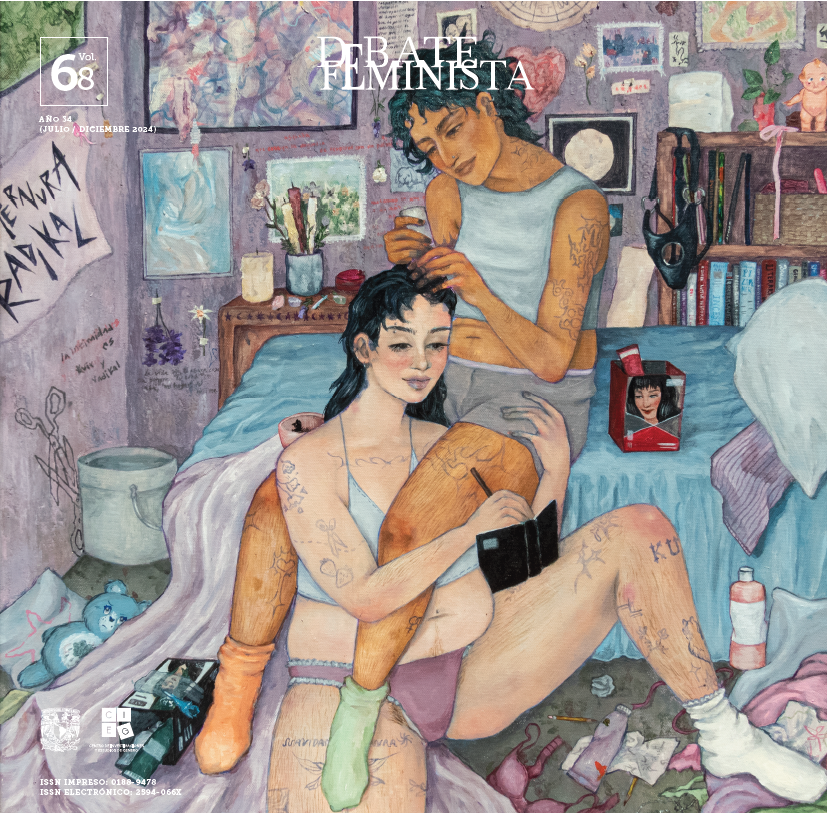Domestic Servitude: Socio-Cultural Isolation and Coercive Labour Relations in Peru
Contenido principal del artículo
Resumen
This article proposes a historical-sociological lens to approach coercive and violent relations within remunerated household labor. Drawing from Orlando Patterson, these relations are understood as interpersonal relations of domination with the concept of domestic servitude. They are analyzed in a qualitative empirical case study on socioculturally isolated domestic workers in Lima, Peru. While the paper attends to scholars concerning migration and domestic work, its main sociological contribution is to empirically and theoretically enrich debates on “unfreedom” beyond economic exploitation. It argues for a reflective and differentiated elaboration on socialcultural dimensions of coercion and violence that are embedded in colonial and patriarchal power structures.
Descargas
Detalles del artículo

Esta obra está bajo una licencia internacional Creative Commons Atribución-NoComercial-SinDerivadas 4.0.
Esta es una publicación bajo la licencia Creative Commons Attribution-Non Commercial-No Derivatives 4.0 International (CC BY-NC- ND 4.0). Para mayor información sobre el uso no comercial de los contenidos que aquí aparecen, favor de consultar http://creativecommons.org/licenses/by-nc-nd/4.0/
Citas
Anderson, Bridget. 2000. Doing the Dirty Work? The Global Politics of Domestic Labor, London, Zed.
Anderson, Bridget. 2010. “Mobilizing Migrants, Making Citizens: Migrant Domestic Workers as Political Agents”, Ethnic and Racial Studies, vol. 33, no. 1, pp. 60-74. DOI: https://doi.org/10.1080/01419870903023660
Braun, Virginia, Victoria Clarke, Nikki Hayfield and Gareth Terry. 2018. “Thematic Analysis”, in Pranee Liamputtong (ed.), Handbook of Research Methods in Health Social Sciences, Singapore, Springer, pp. 1-18. DOI: https://doi.org/10.1007/978-981-10-2779-6_103-1
Chaney, Elsa and Mary García Castro. 1989. Muchachas No More: Household Workers in Latin America and the Caribbean, Philadelphia, Temple University Press.
Cosamalón, Jesús. 2019. “Las otras mujeres. Trabajo, género y etnicidad en la ciudad de Lima en el siglo XIX”, in Claudia Rosas Lauro (ed.), Género y mujeres en la historia del Perú: del hogar al espacio público, Lima, Pontificia Universidad Católica del Perú, pp. 521-542.
Crossa, Veronica. 2012. “Relational Positionality: Conceptualizing Research, Power, and the Everyday Politics of Neoliberalization in Mexico City”, ACME: An International E-journal for Critical Geographies, vol. 11, no. 1, pp. 110-132. DOI: https://doi.org/10.4324/9780203084663-9
Cumes, Aura. 2014. “La casa como espacio de ‘civilización’”, in Séverine Durin, María Eugenia de la O Martínez and Santiago Bastos (coords.), Trabajadoras en la sombra: dimensiones del servicio doméstico latinoamericano, Mexico City, Centro de Investigaciones y Estudios Superiores en Antropología Social, pp. 371-397.
De Vito, Christian, Juliane Schiel and Matthias van Rossum. 2020. “From Bondage to Precariousness. New Perspectives on Labor and Social History”, Journal of Social History, vol. 54, no. 2, pp.1-19. DOI: https://doi.org/10.1093/jsh/shz057
Ehrenreich, Barbara and Arlie Russel Hochschild (ed.). 2003. Global Woman: Nannies, Maids and Sex Workers in the New Economy, New York, Metropolitan Books.
Glenn, Evelyn Nakano. 1992. “From Servitude to Service Work: Historical Continuities in the Racial Division of Paid Reproductive Labor”, Journal of Women in Culture and Society, vol. 18, no. 1, pp. 1-43. DOI: https://doi.org/10.1086/494777
Goldsmith, Mary. 1998. “De sirvientas a trabajadoras. La cara cambiante del servicio doméstico en la ciudad de México”, Debate Feminista, vol. 17, pp. 85-96. DOI: https://doi.org/10.22201/cieg.2594066xe.1998.17.432
Greenland, Fiona. 2019. “Long-range Continuities in Comparative and Historical Sociology: The Case of Parasitism and Women’s Enslavement”, Theory and Society, vol. 48, no. 6, pp. 883–902. DOI: https://doi.org/10.1007/s11186-019-09370-4
hooks, bell. 1981. Ain’t I a Woman: Black Women and Feminism, Boston, South End Press.
ILO (International Labour Organisation). 1930. Convention concerning Forced or Compulsory Labour (No. 29), adopted in Geneva at the 14th ILC Session, 28 June 1930 (entered into force 1 May 1932).
ILO (International Labour Organisation). 2017. Global Estimates of Modern Slavery: Forced Labour and Forced Marriage, Geneva, ILO.
INEI (Instituto Nacional de Estadística e Informática). 2010. Encuesta Nacional de Hogares sobre Condiciones de Vida y Pobreza, Lima, INEI.
INEI (Instituto Nacional de Estadística e Informática). 2017. Resultados Definitivos de los Censos Nacionales 2017, Lima, INEI.
Kuznesof, Elizabeth. 1989. “A History of Domestic Service in Spanish America, 1492–1980”, in Elsa Chaney and Mary García Castor (eds.), Muchachas No More: Household Workers in Latin America and the Caribbean, Philadelphia, Temple University Press, pp. 17-35.
Ley 31047 (2020): Ley núm. 31047 de las Trabajadoras y Trabajadores del Hogar. El Peruano – Normas Legales. Perú: Editora Perú.
Loza, Martha, Paulina Luza, Rosa Mendoza and Flor Valverde. 1990. Así, ando, ando como empleada, Lima, International Programme on the Elimination of Child Labour IPEC and Instituto de Promoción y Formación de Trabajadoras del Hogar IPROFOTH.
Lugones, María. 2010. “Toward a Decolonial Feminism”, Hypatia, vol. 25, no. 4, pp. 742–759. DOI: https://doi.org/10.1111/j.1527-2001.2010.01137.x
Maich, Katherine. 2014. “Marginalized Struggles for Legal Reform: Cross-Country Consequences of Domestic Worker Organizing”, Social Development Issues, vol. 36, no. 3, pp. 73-91.
Mannarelli, María Emma. 2018. La domesticación de las mujeres. Patriarcado y género en la historia peruana, Lima, La Siniestra Ensayos.
Patterson, Orlando and Xiaolin Zhuo. 2018. “Modern Trafficking, Slavery, and Other Forms of Servitude”, Annual Review of Sociology, no. 44, pp. 407-439. DOI: https://doi.org/10.1146/annurev-soc-073117-041147
Patterson, Orlando. 1982. Slavery and Social Death: A comparative Study, Cambridge, Harvard University Press.
Patterson, Orlando. 2012. “Trafficking, Gender and Slavery: Past and Present”, in Jean Allain (ed.), The Legal Understanding of Slavery: From the Historical to the Contemporary, Oxford, Oxford University Press, pp. 322-359. DOI: https://doi.org/10.1093/acprof:oso/9780199660469.003.0018
Patterson, Orlando. 2014. “Sklaverei in globalhistorischer Perspektive: Von der Antike bis in die Gegenwart”, in Winfried Schmitz (ed.), Die Sklaverei setzen wir mit dem Tod gleich: Sklaven in globalhistorischer Perspektive, Stuttgart, Franz Steiner Verlag, pp. 67-104.
Pérez, Leda M. and Luisa Feline Freier. 2020. “Family Bonds: Kinship Reciprocity, Female Teenage Trafficking and Domestic Labor Exploitation in Peru”, Journal of Human Trafficking, vol. 9, no. 1, pp. 48-62. DOI: https://doi.org/10.1080/23322705.2020.1842638
Phillips, Nicola. 2018. “The Politics of Numbers: Beyond Methodological Challenges in Research on Forced Labour”, in Genevieve LeBaron (ed.), Researching Forced Labour in the Global Economy: Methodological Challenges and Advances, Oxford, Oxford University Press, pp. 44-59. DOI: https://doi.org/10.5871/bacad/9780197266472.003.0003
Quijano, Anibal. 2000. “Coloniality of Power and Eurocentrism in Latin America”, International Sociology, vol. 15, no. 2, pp. 215-232. DOI: https://doi.org/10.1177/0268580900015002005
Ray, Raka and Seemin Quayum. 2009. Cultures of Servitude: Modernity, Domesticity and Class in India, New Delhi, Oxford University Press.
Renard, Léa and Theresa Wobbe. 2023. “Free Versus Unfree Labor: Challenging Their Boundaries”, in Lisa Herzog and Bénédicte Zimmermann (eds.), Shifting Categories of Work: Unsettling the Ways We Think about Jobs, Labor, and Activities, New York, Routledge. DOI: https://doi.org/10.4324/9781003341321-10
Rollins, Judith. 1985. Between Women: Domestics and Their Employers, Philadelphia, Temple University Press.
Rossi, Benedetta. 2021. “Promises and Pitfalls of Global Comparisons: Slavery in West African Political Cultures”, African Economic History, vol. 49, no. 1, pp. 15-46. DOI: https://doi.org/10.1353/aeh.2021.0001
Rutté García, Alberto. 1976. Simplemente explotadas. El mundo de las empleadas domésticas de Lima, Lima, Centro de Estudios y Promoción del Desarrollo (Desco).
Salazar Parreñas, Rhacel. 2015. Servants of Globalization: Migration and Domestic Work, Stanford, Stanford University Press. DOI: https://doi.org/10.1515/9780804796187
Salazar Parreñas, Rhacel. 2021. Unfree: Migrant Domestic Work in Arab States, Stanford, Stanford University Press. DOI: https://doi.org/10.1515/9781503629660
Sandoval, Carmen María. 2014. “Trabajo infantil doméstico en un contexto de marginalidad urbana en Lima, Perú”, in Séverine Durin, María Eugenia de la O Martínez and Santiago Bastos (coords.), Trabajadoras en la sombra: dimensiones del servicio doméstico latinoamericano, Mexico City, Centro de Investigaciones y Estudios Superiores en Antropología Social, pp. 111-135.
Steinfeld, Robert J. and Stanley L. Engerman. 1997. “Labor — Free or Coerced? An Historical Reassessment of Differences and Similarities”, in Tom Brass and Marcel van der Linden (eds.), Free and Unfree Labour: The Debate Continues, Bern, Peter Land Academic Publishers, pp. 107-126.
Strauss, Kendra. 2012. “Coerced, Forced and Unfree Labour: Geographies of Exploitation in Contemporary Labour Markets”, Geography Compass, vol. 6, no. 3, pp. 137-148. DOI: https://doi.org/10.1111/j.1749-8198.2011.00474.x
UN (United Nations). 2011. Informe de la Relatora Especial sobre las formas contemporáneas de la esclavitud, incluidas sus causas y consecuencias, sobre su visita al Perú. A /HRC/18/30/Add.2, Geneva, United Nations.
Valdez Carrasco, Bettina del Carmen. 2014. “Empleadoras y trabajadoras del hogar cama adentro: un análisis de género del ejercicio de los derechos laborales en los sectores medios de Lima Metropolitana”, master thesis, Pontificia Universidad Católica del Perú. Available at <http://hdl.handle.net/20.500.12404/5712>.
Van der Linden, Marcel and Magaly Rodríguez García. 2016. On Coerced Labour: Work and Compulsion After Chattel Slavery, Leiden, Brill. DOI: https://doi.org/10.1163/9789004316386
Velásquez Castro, Marcel. 2000. “Las mujeres son menos negras: el caso de las mujeres esclavas en la Lima del siglo XIX”, in Narda Ayin Henríquez (ed.), El hechizo de las imágenes: estatus social, género y etnicidad en la historia peruana, Lima, Pontificia Universidad Católica del Perú, pp. 57-97. DOI: https://doi.org/10.18800/9972423603.003
Wobbe, Theresa, Léa Renard, Nicola Schalkowski and Marianne Braig. 2023. “Deutungsmodelle von Arbeit im Spiegel kolonialer und geschlechtlicher Dimensionen. Kategorisierungsprozesse von ‘Zwangsarbeit’ während der Zwischenkriegszeit”, Zeitschrift für Soziologie, vol. 52, no. 2, pp. 172-190. DOI: https://doi.org/10.1515/zfsoz-2023-2014







